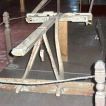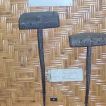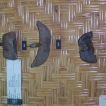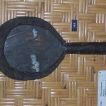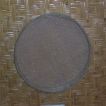In order to produce an optimum quantity of rice a complete farming tools is necessary. Balinese farmer has a wide selection of farming tool based the activity in the field. For example:
1. Land preparation
Land preparation is first step of rice growing phase; these are the tools which are used for land preparation:
a. Hoe (with one tooth, two teeth, four teeth, and six teeth)
b. Sorok (spade)
c. Tulud (leveler)
d. Penampad (long knife)
e. Tengala (plow)
f. Lampit (leveler pull by bull)
2. Seed plantation
After land preparation was finished, the farmers are ready for seed plantation, various tools they are used are:
a. Arit (sickle)
b. Penyepitan Bulih (seed germ pincher)
c. Tempeh (seed basket)
3. Weed extermination and fertilizing
Weeds are serious disturbance to the growth of paddy and fertilization is essential. The tools for exterminating the weed and fertilizing the crop are:
a. Kikis (weeding knife)
b. Pengrondoan (raking)
4. Waiting paddy to ripe
Near harvest, the farmers are waiting rice to ripe. They made scarecrow to protect the crops fro sparrow, and noisy bamboo to make a loud noise to scare the sparrow. The tools for this phase are:
a. Kepuakan (noising bamboo)
b. Lelakut (scarecrow)
5. Harvest
Harvest is always a time of joy for the farmer and of course a time for hard work. The tools that are used for harvesting are:
a. Anggapan (rice pinnacle cutter)
b. Sanggah Dewa (Spirit house of Dewa Nini (female spirit of rice)
c. Penatapan (tool for leveling the bind paddy)
d. Pangeretan tali (tool for tighten the paddy bind)
e. Arit (sickle)
f. Tali penepukan (rope for binding paddy)
6. Transporting and storing rice
After harvesting the farmers carry the rice stalk from rice field to the granary in their house compound.Women carry the rice by putting the on their head and man by putting them on their shoulder. The tools for transporting and storing the rice are:
a. Pega (tool for conveying the rice stalk form the ground to the head)
b. Sanan (a long bamboo or wood for carrying the rice stalk on the shoulder)
7. Rice processing
The rice processing is usually conducted in a house compound. The tools for rice processing are:
a. Nyiru (winnowing basket)
b. Sidi (sieve)
c. Lu (tool for pounding the rice)
d. Sok (basket)
e. Ketungan (tool for pounding the rice)
8. Grain processing
The grain processing is the last phase in rice production based on Balinese traditional rice production process. The tools used in this process are:
a. Lesung (mortar)
b. Nyiru (winnowing basket)
c. Panarak (basket)
d. Patan (rice measurement device: 0.5 kg)
e. Cengkilik (rice measurement device: 0.25 kg)
f. Lu (tool for pounding the rice)
All these tools are traditional farming tools; the advance of technology brings modern tools and machine to the rice field such as tractors, backpack fertilizer pump, harvest machine and many type of grain processing machine. These new devices are used wisely by the Balinese farmers in accordance with Tri Hita Karana principle. Not just the tools that undergo a change but also the subak as an organization can not escape from the clutch of change.
Water management in Bali is not only a matter of distributing water among farmers within a subak, but also among several subak in a river course. In a river stream there are usually dozens of subak. Often, several subak share a dam. The water is then divided through diversion weirs further down into the single subak. To improve irrigation water management and coordination the government implemented another irrigation management level in 1981, a federation of several subak which share irrigation infrastructure. They were called subak gede. The term subak-gede has been known already during the period of the Dutch occupation and means literally large subak.
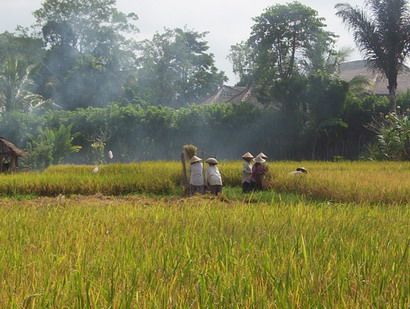
The main responsibility of the subak-gede is optimal water distribution amongst the five subak. Thesubak heads come together several times per year to discuss how the water is distributed for the next few months. As irrigation water is the crucial ecological variable, the cultivation cycles have to be staggered within the five subak. Also, the regular face-to-face interaction among the five subak heads allows greater flexibility in water management during times of water shortage. The strengthening of the intersubak institutions brought benefits to the irrigation system. The establishment of the subak-gedehas enabled the subak heads to coordinate and prepare certain larger rice cultivation ceremonies together and therefore reduce time and labor input as well as expenditures.

All that change show the great adaptability of Subak to modernization and development. Despite of its great adaptability Subak does not lose its hallmark as a product of traditional Balinese culture. Subakstill preserves its Tri Hita Karana principle as its code of conduct, code of honor, and code of life.
source:blog.baliwww.com/



















